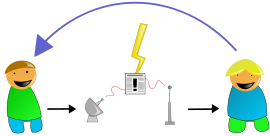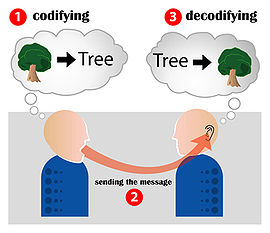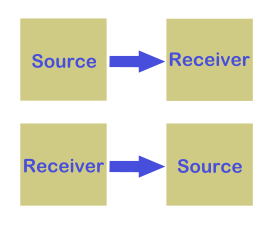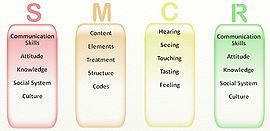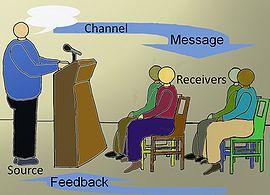- Communication
-
For the term used in the game of bridge, see Glossary of contract bridge terms # communication.
Communication is the activity of conveying meaningful information. Communication requires a sender, a message, and an intended recipient, although the receiver need not be present or aware of the sender's intent to communicate at the time of communication; thus communication can occur across vast distances in time and space. Communication requires that the communicating parties share an area of communicative commonality. The communication process is complete once the receiver has understood the message of the sender.
Contents
Human communication
Human spoken and picture languages can be described as a system of symbols (sometimes known as lexemes) and the grammars (rules) by which the symbols are manipulated. The word "language" also refers to common properties of languages. Language learning normally occurs most intensively during human childhood. Most of the thousands of human languages use patterns of sound or gesture for symbols which enable communication with others around them. Languages seem to share certain properties, although many of these include exceptions. There is no defined line between a language and a dialect. Constructed languages such as Esperanto, programming languages, and various mathematical formalisms are not necessarily restricted to the properties shared by human languages.
A variety of verbal and non-verbal means of communicating exists such as body language, eye contact, sign language, paralanguage, haptic communication, chronemics, and media such as pictures, graphics, sound, and writing.
Convention on the Rights of Persons with Disabilities also defines the communication to include the display of text, Braille, tactile communication, large print, accessible multimedia, as well as written and plain language, human reader, and accessible information and communication technology.[1]
Nonverbal communication
Nonverbal communication describes the process of conveying meaning in the form of non-word messages. Research shows that the majority of our communication is non verbal, also known as body language. Some of non verbal communication includes chronemics, haptics, proxemics[2], gesture, body language or posture; facial expression and eye contact, object communication such as clothing, hairstyles, architecture, symbols infographics, and tone of voice as well as through an aggregate of the above.
Speech also contains nonverbal elements known as paralanguage. These include voice lesson quality, emotion and speaking style as well as prosodic features such as rhythm, intonation and stress. Likewise, written texts include nonverbal elements such as handwriting style, spatial arrangement of words and the use of emoticons to convey emotional expressions in pictorial form.
Oral communication
Oral communication, while primarily referring to spoken verbal communication, typically relies on both words, visual aids and non-verbal elements to support the conveyance of the meaning. Oral communication includes discussion, speeches, presentations, interpersonal communication and many other varieties. In face to face communication the body language and voice tonality plays a significant role and may have a greater impact on the listener than the intended content of the spoken words.
A great presenter must capture the attention of the audience and connect with them. For example, out of two persons telling the same joke one may greatly amuse the audience due to his body language and tone of voice while the second person, using exactly the same words, bores and irritates the audience.[citation needed] Visual aid can help to facilitate effective communication and is almost always used in presentation for an audience.
A widely cited and widely misinterpreted figure used to emphasize the importance of delivery states that "communication comprise 55% body language, 38% tone of voice, 7% content of words", the so-called "7%-38%-55% rule".[3] This is not however what the cited research shows – rather, when conveying emotion, if body language, tone of voice, and words disagree, then body language and tone of voice will be believed more than words.[4][clarification needed] For example, a person saying "I'm delighted to meet you" while mumbling, hunched over, and looking away will be interpreted as insincere. (Further discussion at Albert Mehrabian: Three elements of communication.)'
Written communication and its historical development
Over time the forms of and ideas about communication have evolved through progression of technology. Advances include communications psychology and media psychology; an emerging field of study. Researchers divide the progression of written communication into three revolutionary stages called "Information Communication Revolutions".[citation needed]
During the first stage, written communication first emerged through the use of pictographs. The pictograms were made in stone, hence written communication was not yet mobile.
During the second stage, writing began to appear on paper, papyrus, clay, wax, etc. Common alphabets were introduced and allowed for the uniformity of language across large distances. A leap in technology occurred when the Gutenberg printing-press was invented in the 15th century.
The third stage is characterised by the transfer of information through controlled waves and electronic signals.
Communication is thus a process by which meaning is assigned and conveyed in an attempt to create shared understanding. This process, which requires a vast repertoire of skills in interpersonal processing, listening, observing, speaking, questioning, analyzing, gestures, and evaluating enables collaboration and cooperation.[5]
Misunderstandings can be anticipated and solved through formulations, questions and answers, paraphrasing, examples, and stories of strategic talk. Written communication can be clear by planning follow-up talk on critical written communication as part of the normal way of doing business. Minutes spent talking now will save time later having to clear up misunderstandings later on. Then, take what was heard and reiterate in your own words, and ask them if that’s what they meant.[6]
Barriers to effective human communication
Communication is the key factor in the success of any organization. When it comes to effective communication, there are certain barriers that every organization faces. People often feel that communication is as easy and simple as it sounds. No doubt, but what makes it complex, difficult and frustrating are the barriers that come in its way. some of these barriers are mentioned below.
Barriers to successful communication include message overload (when a person receives too many messages at the same time), and message complexity.[7]
Physical barriers: Physical Barriers are often due to the nature of the environment.Thus, for example, the natural barrier which exists, if staff are located in different buildings or on different sites.Likewise, poor or outdated equipment, particularly the failure of management to introduce new technology, may also cause problems.Staff shortages are another factor which frequently causes communication difficulties for an organization. Whilst distractions like background noise, poor lighting or an environment which is too hot or cold can all affect people's morale and concentration, which in turn interfere with effective communication.
System design: System Design faults refer to problems with the structures or systems in place in an organization. Examples might include an organizational structure which is unclear and therefore makes it confusing to know who to communicate with. Other examples could be inefficient or inappropriate information systems, a lack of supervision or training, and a lack of clarity in roles and responsibilities which can lead to staff being uncertain about what is expected of them.
Attitudinal barriers: Attitudinal Barriers come about as a result of problems with staff in an organisation. These may be brought about, for example, by such factors as poor management, lack of consultation with employees, personality conflicts which can result in people delaying or refusing to communicate, the personal attitudes of individual employees which may be due to lack of motivation or dissatisfaction at work, brought about by insufficient training to enable them to carry out particular tasks, or just resistance to change due to entrenched attitudes and ideas.
Ambiguity of Words/Phrases: Words sounding same but having different meaning can convey a different meaning altogether. Hence the communicator must ensure that the receiver receives the same meaning. It would be better if such words can be avoided by using alternatives.
Individual linguistic ability; is also important. The use of difficult or inappropriate words in communication can prevent people from understanding the message.Poorly explained or misunderstood messages can also result in confusion. We can all think of situations where we have listened to something explained which we just could not grasp.
Physiological barriers: may result from individuals' personal discomfort, caused, for example, by ill health, poor eye sight or hearing difficulties.
Presentation of information: is also important to aid understanding. Simply put, the communicator must consider the audience before making the presentation itself and in cases where it is not possible the presenter can at least try to simplify his/her vocabulary so that majority can understand.
Nonhuman communication
See also: Biocommunication (science) and Interspecies communicationEvery information exchange between living organisms — i.e. transmission of signals that involve a living sender and receiver can be considered a form of communication; and even primitive creatures such as corals are competent to communicate. Nonhuman communication also include cell signaling, cellular communication, and chemical transmissions between primitive organisms like bacteria and within the plant and fungal kingdoms.
Animal communication
The broad field of animal communication encompasses most of the issues in ethology. Animal communication can be defined as any behavior of one animal that affects the current or future behavior of another animal. The study of animal communication, called zoosemiotics' (distinguishable from anthroposemiotics, the study of human communication) has played an important part in the development of ethology, sociobiology, and the study of animal cognition. Animal communication, and indeed the understanding of the animal world in general, is a rapidly growing field, and even in the 21st century so far, many prior understandings related to diverse fields such as personal symbolic name use, animal emotions, animal culture and learning, and even sexual conduct, long thought to be well erstood, have been revolutionized.
Plants and fungi
Communication is observed within the plant organism, i.e. within plant cells and between plant cells, between plants of the same or related species, and between plants and non-plant organisms, especially in the root zone. Plant roots communicate in parallel with rhizome bacteria, with fungi and with insects in the soil. These parallel sign-mediated interactions are governed by syntactic, pragmatic, and semantic rules, and are possible because of the decentralized "nervous system" of plants. The original meaning of the word "neuron" in Greek is "vegetable fiber" and recent research has shown that most of the intraorganismic plant communication processes are neuronal-like.[8] Plants also communicate via volatiles when exposed to herbivory attack behavior to warn neighboring plants. In parallel they produce other volatiles to attract parasites which attack these herbivores. In stress situations plants can overwrite the genetic code they inherited from their parents and revert to that of their grand- or great-grandparents.
Fungi communicate to coordinate and organize their growth and development such as the formation of mycelia and fruiting bodies. Fungi communicate with same and related species as well as with nonfungal organisms in a great variety of symbiotic interactions, especially with bacteria, unicellular eukaryotes, plants and insects through semiochemicals of biotic origin. The semiochemicals trigger the fungal organism to react in a specific manner, while if the same chemical molecules are not part of biotic messages, they do not trigger the fungal organism to react. This implies that fungal organisms can differ between molecules taking part in biotic messages and similar molecules being irrelevant in the situation. So far five different primary signalling molecules are known to coordinate different behavioral patterns such as filamentation, mating, growth, and pathogenicity. Behavioral coordination and production of signalling substances is achieved through interpretation processes that enables the organism to differ between self or non-self, abiotic indicator, biotic message from similar, related, or non-related species, and even filter out "noise", i.e. similar molecules without biotic content.
Bacteria quorum sensing
Communication is not a tool used only by humans, plants and animals, but it is also used by microorganisms like bacteria. The process is called quorum sensing. Through quorum sensing, bacteria are able to sense the density of cells, and regulate gene expression accordingly. This can be seen in both gram positive and gram negative bacteria. This was first observed by Fuqua et al. in marine microorganisms like V.harveyi and V.fischeri.[9]
Communication cycle
The first major model for communication came in 1949 by Claude Shannon and Warren Weaver for Bell Laboratories[10] The original model was designed to mirror the functioning of radio and telephone technologies. Their initial model consisted of three primary parts: sender, channel, and receiver. The sender was the part of a telephone a person spoke into, the channel was the telephone itself, and the receiver was the part of the phone where one could hear the other person. Shannon and Weaver also recognized that often there is static that interferes with one listening to a telephone conversation, which they deemed noise.
In a simple model, often referred to as the transmission model or standard view of communication, information or content (e.g. a message in natural language) is sent in some form (as spoken language) from an emisor/ sender/ encoder to a destination/ receiver/ decoder. This common conception of communication simply views communication as a means of sending and receiving information. The strengths of this model are simplicity, generality, and quantifiability. Social scientists Claude Shannon and Warren Weaver structured this model based on the following elements:
- An information source, which produces a message.
- A transmitter, which encodes the message into signals
- A channel, to which signals are adapted for transmission
- A receiver, which 'decodes' (reconstructs) the message from the signal.
- A destination, where the message arrives.
Shannon and Weaver argued that there were three levels of problems for communication within this theory.
- The technical problem: how accurately can the message be transmitted?
- The semantic problem: how precisely is the meaning 'conveyed'?
- The effectiveness problem: how effectively does the received meaning affect behavior?
Daniel Chandler critiques the transmission model by stating:
- It assumes communicators are isolated individuals.
- No allowance for differing purposes.
- No allowance for differing interpretations.
- No allowance for unequal power relations.
- No allowance for situational contexts.
In 1960, David Berlo expanded on Shannon and Weaver’s (1949) linear model of communication and created the SMCR Model of Communication.[11] The Sender-Message-Channel-Receiver Model of communication separated the model into clear parts and has been expanded upon by other scholars.
Communication is usually described along a few major dimensions: Message (what type of things are communicated), source / emisor / sender / encoder (by whom), form (in which form), channel (through which medium), destination / receiver / target / decoder (to whom), and Receiver. Wilbur Schram (1954) also indicated that we should also examine the impact that a message has (both desired and undesired) on the target of the message.[12] Between parties, communication includes acts that confer knowledge and experiences, give advice and commands, and ask questions. These acts may take many forms, in one of the various manners of communication. The form depends on the abilities of the group communicating. Together, communication content and form make messages that are sent towards a destination. The target can be oneself, another person or being, another entity (such as a corporation or group of beings).
Communication can be seen as processes of information transmission governed by three levels of semiotic rules:
- Syntactic (formal properties of signs and symbols),
- Pragmatic (concerned with the relations between signs/expressions and their users) and
- Semantic (study of relationships between signs and symbols and what they represent).
Therefore, communication is social interaction where at least two interacting agents share a common set of signs and a common set of semiotic rules. This commonly held rule in some sense ignores autocommunication, including intrapersonal communication via diaries or self-talk, both secondary phenomena that followed the primary acquisition of communicative competences within social interactions.
In light of these weaknesses, Barnlund (2008) proposed a transactional model of communication.[13] The basic premise of the transactional model of communication is that individuals are simultaneously engaging in the sending and receiving of messages.
In a slightly more complex form a sender and a receiver are linked reciprocally. This second attitude of communication, referred to as the constitutive model or constructionist view, focuses on how an individual communicates as the determining factor of the way the message will be interpreted. Communication is viewed as a conduit; a passage in which information travels from one individual to another and this information becomes separate from the communication itself. A particular instance of communication is called a speech act. The sender's personal filters and the receiver's personal filters may vary depending upon different regional traditions, cultures, or gender; which may alter the intended meaning of message contents. In the presence of "communication noise" on the transmission channel (air, in this case), reception and decoding of content may be faulty, and thus the speech act may not achieve the desired effect. One problem with this encode-transmit-receive-decode model is that the processes of encoding and decoding imply that the sender and receiver each possess something that functions as a codebook, and that these two code books are, at the very least, similar if not identical. Although something like code books is implied by the model, they are nowhere represented in the model, which creates many conceptual difficulties.
Theories of coregulation describe communication as a creative and dynamic continuous process, rather than a discrete exchange of information. Canadian media scholar Harold Innis had the theory that people use different types of media to communicate and which one they choose to use will offer different possibilities for the shape and durability of society (Wark, McKenzie 1997). His famous example of this is using ancient Egypt and looking at the ways they built themselves out of media with very different properties stone and papyrus. Papyrus is what he called 'Space Binding'. it made possible the transmission of written orders across space, empires and enables the waging of distant military campaigns and colonial administration. The other is stone and 'Time Binding', through the construction of temples and the pyramids can sustain their authority generation to generation, through this media they can change and shape communication in their society (Wark, McKenzie 1997).
Bernard Luskin, UCLA, 1970, advanced computer assisted instruction and began to connect media and psychology into what is now the field of media psychology. In 1998, the American Association of Psychology, Media Psychology Division 46 Task Force report on psychology and new technologies combined media and communication as pictures, graphics and sound increasingly dominate modern communication.
Communication noise
In any communication model, noise is interference with the decoding of messages sent over a channel by an encoder. There are many examples of noise:
Environmental Noise: Noise that physically disrupts communication, such as standing next to loud speakers at a party, or the noise from a construction site next to a classroom making it difficult to hear the professor.
Physiological-Impairment Noise: Physical maladies that prevent effective communication, such as actual deafness or blindness preventing messages from being received as they were intended.
Semantic Noise: Different interpretations of the meanings of certain words. For example, the word "weed" can be interpreted as an undesirable plant in your yard, or as a euphemism for marijuana.
Syntactical Noise: Mistakes in grammar can disrupt communication, such as abrupt changes in verb tense during a sentence.
Organizational Noise: Poorly structured communication can prevent the receiver from accurate interpretation. For example, unclear and badly stated directions can make the receiver even more lost.
Cultural Noise: Stereotypical assumptions can cause misunderstandings, such as unintentionally offending a non-Christian person by wishing them a "Merry Christmas".
Psychological Noise: Certain attitudes can also make communication difficult. For instance, great anger or sadness may cause someone to lose focus on the present moment. Disorders such as Autism may also severely hamper effective communication.[14]
Communication as academic discipline
Main article: Communication theorySee also
- Advice
- Sign system
- SPEAKING
- Telecommunication
- Data communication
- Telepathy
References
- ^ Convention on the Rights of Persons with Disability, Article 2, Definition
- ^ http://fevgroup.wordpress.com/2007/09/18/culture-and-nonverbal-communication/
- ^ Mehrabian, Albert (1971). Silent Messages (1st ed.). Belmont, CA: Wadsworth.
- ^ Debunking the 55%, 38%, 7% Rule, by Judith E. Pearson
- ^ "communication". The office of superintendent of Public Instruction. Washington.
- ^ Heyman, Richard. Why Didn't You Say That in the First Place? How to Be Understood at Work.
- ^ Montana, Patrick J. & Charon, Bruce H. 2008. Management. 4th ed. New York. Barron's Educational Series, Inc. Pg 333.
- ^ Baluska, F.; Marcuso, Stefano; Volkmann, Dieter (2006). Communication in plants: neuronal aspects of plant life. Taylor & Francis US. p. 19. ISBN 3540284758. http://books.google.com/books?id=IH9N4SKWTokC&pg=PA19&dq=plant+communication+processes+are+neuronal-like#v=onepage&q=plant%20communication%20processes%20are%20neuron-like&f=false. "...the emergence of plant neurobiology as the most recent area of plant sciences."
- ^ Template:Http://m.biotecharticles.com/Biology-Article/Quorum-Sensing-Communication-Plan-For-Microbes-517.html
- ^ Shannon, C. E., & Weaver, W. (1949). The mathematical theory of communication. Urbana, Illinois: University of Illinois Press
- ^ Berlo, D. K. (1960). The process of communication. New York, New York: Holt, Rinehart, & Winston.
- ^ Schramm, W. (1954). How communication works. In W. Schramm (Ed.), The process and effects of communication (pp. 3-26). Urbana, Illinois: University of Illinois Press.
- ^ Barnlund, D. C. (2008). A transactional model of communication. In. C. D. Mortensen (Eds.), Communication theory (2nd ed., pp47-57). New Brunswick, New Jersey: Transaction.
- ^ Roy M. Berko, et al., Communicating. 11th ed. (Boston, MA: Pearson Education, Inc., 2010) 9-12
- Daniel Chandler, "The Transmission Model of Communication", Aber.ac.uk
- Heyman, Richard. Why Didn't You Say That in the First Place? How to Be Understood at Work. 1st. San Francesco, Ca: Jossey-Bass Inc., 1994. Print.
External links
- Introduction to Human Communication
- [1] Barriers to Effective Communication
Categories:
Wikimedia Foundation. 2010.

